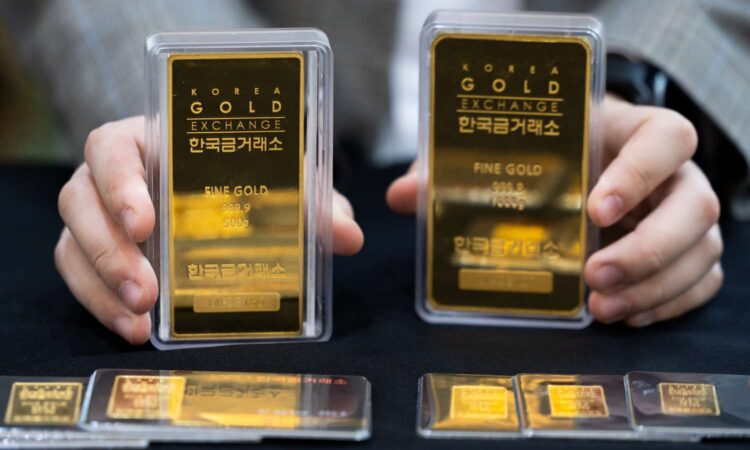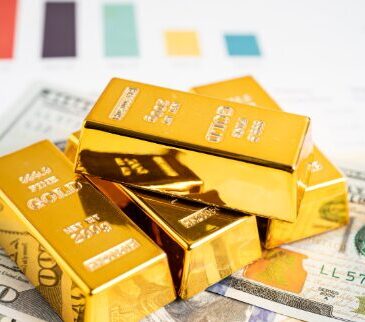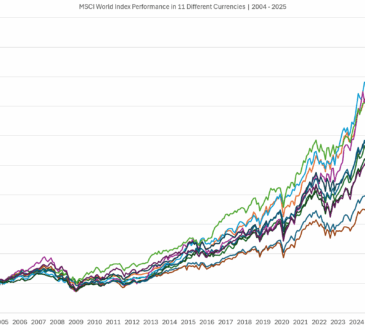
Throughout the ages, gold has captivated humanity. At the end of the gold standard, there was an increase in financial instability and inflation. During the stock market crashes in the first decade of the 21st century, the price of gold rose. The idea of returning to the gold standard became more popular at that time. Admittedly, there were inherent problems with the gold standards implemented in the 19th and 20th centuries.
Many people fail to realize that gold is a currency under the current system. Gold has often been thought of in relation to the U.S. dollar (USD), mainly because it is usually priced in U.S. dollars. There is a long-term negative correlation between the dollar and gold prices. These factors must be considered when we see that the price of gold is simply an exchange rate. Just as one can exchange U.S. dollars for Japanese yen, a paper currency can be exchanged for gold.
Key Takeaways
- Throughout human history, gold has been used as a money form in one way or another.
- From gold coins to paper notes backed by the gold standard, only recently has money moved to a fiat system that is not backed by a physical commodity.
- Since then, inflation and a declining dollar have meant rising gold prices.
- By purchasing gold, people can also shelter themselves from times of global economic uncertainty.
Gold Is a Currency
Under a free market system, gold is a currency. Gold has a price, and that price will fluctuate relative to other forms of exchange, such as the U.S. dollar, the euro (EUR), and the Japanese yen (JPY). Gold can be bought and stored, but it is not usually used directly as a method of payment. However, it is highly liquid and can be converted to cash in almost any currency with relative ease.
It follows that gold acts like other currencies in many ways. There are times when gold is likely to move higher and times when other currencies or asset classes usually outperform. We can expect gold to perform well when confidence in paper currencies is waning, during wars, and when stocks suffer significant losses. Gold is frequently seen as a safe haven during times of market or geopolitical turmoil.
Investors can trade gold in multiple ways, including buying physical gold, gold futures contracts, and gold exchange-traded funds (ETFs). Investors can also participate in the price movements without owning the underlying asset by purchasing a contract for differences (CFD).
Gold and the U.S. Dollar
Gold and the U.S. dollar have always had an interesting relationship. Over the long term, a declining dollar meant rising gold prices, and vice versa. In the short run, the relationship can break down, so the best that can be said is that gold has only a slight negative correlation to the U.S. dollar.
In the charts above (both of which show weekly data over the past five years), we can see at the far right (the most recent price data) a top in the U.S. dollar index followed by a sharp decline. At the same time, gold makes a significant low followed by a sharp rebound. This is an example of the two assets moving inversely to each other, at least in the current environment.
But what’s the fundamental picture behind these price movements? The short answer is interest rates and interest rate expectations. The U.S. dollar high is the result of rising interest rates in the United States, while the subsequent decline is due to a change in interest rate expectations—namely that the Federal Reserve may not continue to hike as aggressively in 2023 as they did in 2022.
The same can be said of gold, but inversely. Gold falls as U.S. interest rates increase (and the USD increases), but then rebound as U.S. rate hike expectations are scaled back, causing gold to put in a potentially significant bottom.
Importantly, both the U.S. dollar and gold are considered safe-haven assets in times of turmoil, with the U.S. dollar winning out during periods of extreme market distress, and gold trailing a bit as commodities generally decline. What’s more, gold can be traded against other major currencies, so investors can take advantage of U.S. dollar strength/weakness alongside gold strength/weakness.
For instance, let’s say current news is bad and markets are experiencing negative volatility, meaning stock markets are declining and Treasury prices are rising. At times such as these when it comes to currencies, investors may flock to the safe-haven assets of gold and the U.S. dollar, with the greenback seeing the most of the flows due to its greater liquidity.
But the two currencies may both be exploited by buying gold against another non-USD currency. How can this be done? Traders and investors can sell EUR/USD, for an example of one such dollar-based pair, and simultaneously buy gold (XAU/USD), in effect selling EUR/XAU. The same can be done for other non-USD currencies; e.g., selling GBP/XAU or JPY/XAU. (Two trades may be necessary because not all trading platforms offer pricing in gold vs. other non-USD major currencies.)
Using Gold as a Currency
As of this writing, gold and the U.S. dollar seem set to ply an inverse course from each other. Global central banks are in the process of raising rates to combat inflation, threatening global growth overall. But as data accumulates that inflation has peaked and begun to recede, interest rate expectations are also being scaled back. Make no mistake, this is a very volatile environment and is highly data-dependent (the Consumer Price Index [CPI], personal consumption expenditures [PCE], and other inflation indicators), but one that is based on interest rate changes and expectations going forward.
The U.S. dollar is most likely to track interest rate expectations more closely than gold, which will be more sensitive to overall market volatility, which in turn will depend on interest rate expectations. And now we’ve come full circle, with both the USD and gold dependent on the future direction of interest rates and related incoming data. Investors should note the technical patterns that each asset is displaying.
There are times when it is favorable to own gold and other times when the overall trend in gold will be unclear or negative. Even though the official gold standards are now gone, gold continues to be impacted by other currencies. Therefore, gold must be traded like other currencies.
By purchasing gold, people can shelter themselves from times of global economic uncertainty. Trends and reversals occur in any currency, and this is also true for gold. Gold is a proactive investment to hedge against potential risks to paper currency. Once the threat materializes, gold’s advantage may have already disappeared. Therefore, gold is forward-looking, and those who trade it must be forward-looking as well.
Does Gold Follow the U.S. Dollar (USD)?
It varies according to circumstances. The best barometer of the relationship between gold and the USD is interest rates and interest rate expectations. The U.S. dollar will most closely follow the path of U.S. and global interest rates, while gold will tend to move inversely.
Can Gold Be Traded Like Other Currency Pairs?
Yes. While the bulk of gold volume is against the USD, gold can still be traded against other currencies depending on the setup. For example, in a scenario in which U.S. interest rates are on hold for the foreseeable future, while euro rates are set to rise, investors could look to buy EUR and sell gold (sell EUR/XAU) as an active currency pair.
What Is the Main Driver of Gold Prices?
As with other currency pairs, interest rates and interest rate expectations are the biggest long-term factors driving gold. On a day-to-day basis, however, general short-term volatility in commodities and the USD will have a mostly inverse impact on the yellow metal.
Is Gold a Safe-Haven Asset?
Once again, it depends on the nature and degree of the negative volatility that lies behind the news. Mildly negative market conditions suggest gold would reap some safe-haven inflows. But more significant volatility will see gold fade alongside other commodities, while the USD should strengthen the most. The most important thing to remember is to treat gold as its own tradable currency, its own asset class, thus avoiding confusion about the fate of other currency pairs.
The Bottom Line
Under a free market system, gold should be viewed as a currency like the euro, the Japanese yen, and the U.S. dollar. Gold has a long-standing relationship with the U.S. dollar, and it generally moves in the opposite direction in the long run.
Viewing gold as a currency and trading it as such can mitigate risks to paper currency and the economy. As with all currency pairs, investors should be aware that gold is forward-looking. If one waits until disaster strikes, then the gold price may already have risen too high to offer protection.



